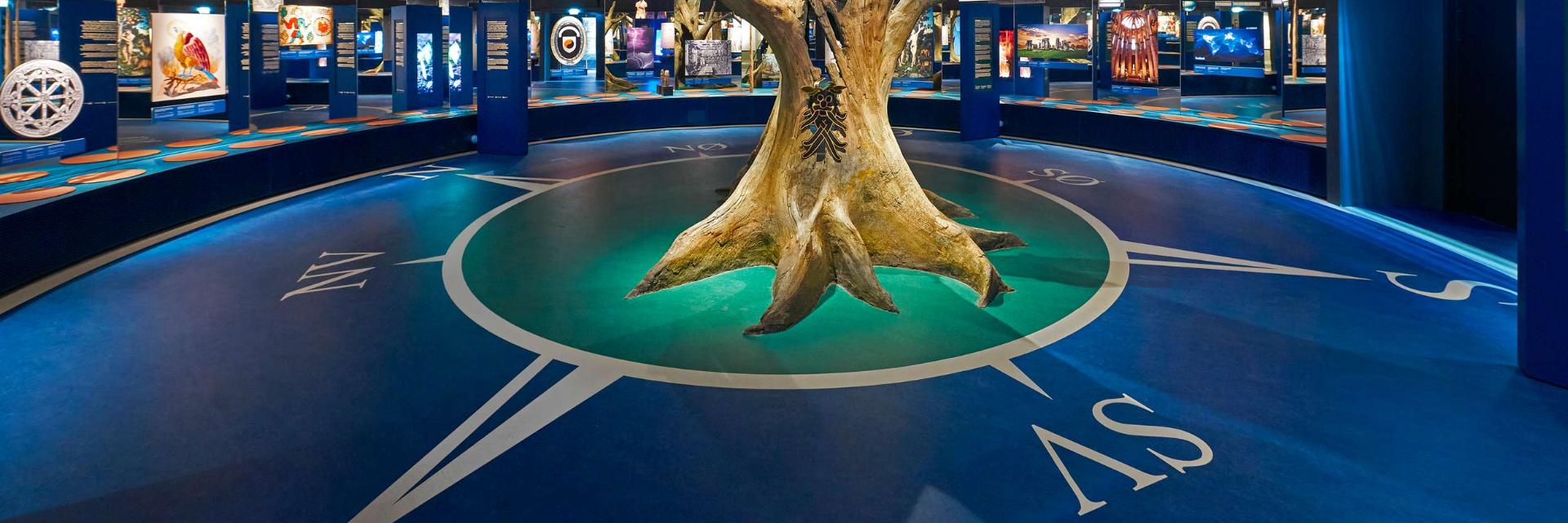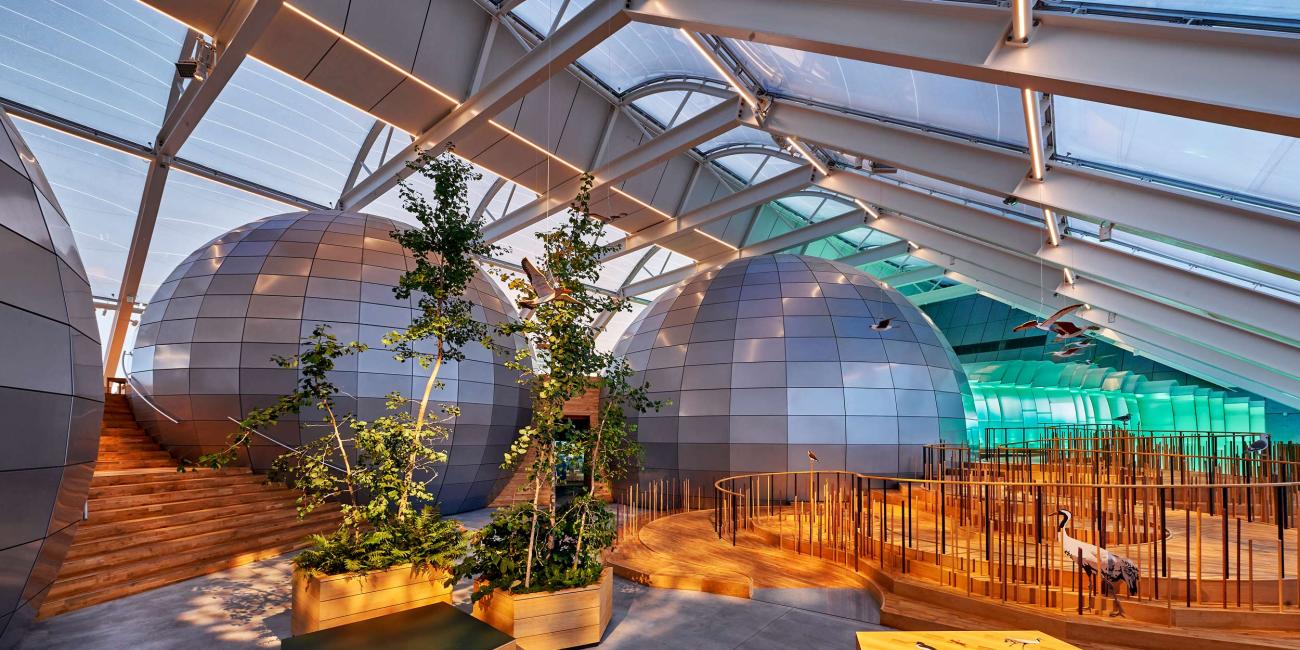
Naturkraft
And there was light – in Naturkraft
Each time you drive past Naturkraft, you experience the building as for the first time. In the evening, the light is warm, and the three domes are lit up with colours that change with the seasons. During the day, the light is cold and bright. The light follows the rhythm of daylight and supports the presentation of nature, which is the focal point of the experience centre by Ringkøbing Fjord.
Naturkraft conveys the forces of nature so that you feel it with every inch of your body. The building is a large tent which enhances the sensation of light and sound: when it rains, the roof acts like a drumhead, and the outside light gives colour to the space inside.
Peter Sand, director of Naturkraft, and his people wanted a house full of life around the clock 365 days a year. It was important that the building was as interesting when closed as when open. That there is something about the building when you drive past in the evening and you can sense that something is going on inside.
–In the evening, Naturkraft is exceptional. You simply get the chills. You feel like you´re in a completely different place," says Peter Sand.
Intelligent control system and clever colour solutions
Jens-Erik Thøgersen, partner at Thøgersen & Stouby, is the architect behind the building and the entire experience universe of Naturkraft. He makes no secret of the fact that lighting in a transparent building like Naturkraft is an extremely difficult task:
– I wanted the lighting to work with the outside light. Even at time of the year when there isn't much light. The challenge is that the lighting needs to respond to the changing of seasons and light, going from zero to 200 lux when the sun is up. The light must not appear pale in summer when the sun is setting. I actually think the artificial lighting of the house has succeeded in living with the light outside.
The lighting in the building is controlled by an intelligent control system that turns the lights up and down in accordance with the rhythm of daylight:
– The intelligent control system, which changes the light during the day and takes on a different hue in twilight and at night, makes the light exciting all day and all year round, says Jens-Erik Thøgersen.
Red thread with light
The lighting assignment at Naturkraft was carried out by Gobo, which provides lighting and lighting equipment for museums and other exhibition venues. Gobo provided design lighting for the open space and exhibitions - apart from the special exhibition - and for the installation and integration of the lighting.
According to Jens Lind, director of Gobo and project manager on the lighting assignment, the challenge was to make the light work together so that it followed the rhythm of the day and supported the storytelling at Naturkraft:
– We have worked closely with the partners to create a common theme in the lighting throughout the building that supports the stories being told. We have played with colours and with colour temperatures. The lighting techniques have been carried through and used in the entire building.
And according to the architect, the ambition was fulfilled:
– The solution is not only in the automated control but very much in the settings chosen for the different lighting conditions. These are intelligent colour solutions that highlight the building in the best possible way," says Jens-Erik Thøgersen.
Light meets projection
Naturkraft consists of large open exhibition areas and dark exhibition rooms with sensory installations.
One of the challenges of the lighting set-up in Naturkraft was the shift between the very bright exhibition areas and the completely dark exhibition spaces. Here the task was to make the light play together with the projections that are part of the installations.
A major work in Naturkraft is The Tree of Life. Here you follow the tree from its blossoming in spring to its beautiful leaf fall in a 12-minute loop. The effect is created via projection with 6 powerful video projectors on a large celestial sphere.
Morten Ranmar, creative director of No Parking, the company behind The Tree of Life, says that projection is the main light source in the exhibition space.
– The work is the main source of light. It takes up more than half the space. All you sense is projection. So, the projection provides the light in the room, which is amplified by projections in the forest floor.
The challenge was to create a lighting that did not lead the attention away from the projection. Morten Ranmar worked closely with Jens Lind from Gobo to find the right balance:
– Normally projections and light do not belong together. And if the lighting designer is involved late in the development process, you often find that he wastes light on the projection. But Jens understands that the projection must have maximum contrast. I think Jens has created a sophisticated solution that supports the work.
Disorientation as a lighting strategy
The Tree of Life is a work sensed with the body. You feel you are standing under a real tree, you sense the snow, the twilight, the green leaves in spring and the orange-red leaves in autumn - and the colours are turned up a notch.
Morten Ranmar and Jens Lind agreed that the focus should be on the sensory experience and chose to create minimal lighting, as in a cinema. Discreet spotlighting and a minimum of wayfinding were used at entrances and exits, but there is less light in the middle of the room and upwards, so that you are caught up in the sensory experience.
As part of enhancing the sensory experience, Morten Ranmar and Jens Lind worked to create disorientation via a minimum of light:
– When you move from the very bright to the very dark rooms, you lose your orientation. And we wanted to maintain that sense of disorientation. It's a point that you have to be vigilant. Just as the forest floor is not lit, there is no light beyond what is safe, says Morten Ranmar.
If you ask architect Jens-Erik Thøgersen whether they succeeded in making light and projections play together in the dark rooms, the answer is a resounding yes:
– The scenographic effect of lighting is perfectly exploited in the dark exhibition spaces - especially in the scenography around The Tree of Life. Here there is a natural rhythm of light provided by the projections, which the spotlight complements well.
Morten Ranmar and Jens Lind have also worked closely together on The Wave - a giant light installation that you walk inside. Video projections and sound create the sensation of standing inside a roaring wave. The two lighting designers had many visits to Spekta, who made The Wave. Here they worked on a prototype and experimented with how the light could support the experience to the fullest.

The light is half of the exhibition
Gobo has also had a hand in designing the light in Naturkraft's first special exhibition The Legacy, created by exhibition architect Eskild Bjerre Laursen. The Legacy is about man's quest to understand himself in relation to the outside world throughout time.
The exhibition includes mobiles that rotate, and Gobo has provided the profile spots that light up the mobiles. There was no real collaboration in this case, as Eskild Bjerre Laursen is known for providing the lighting for his own exhibitions. But the profile lights are an important element in supporting Eskild Bjerre Laursen's scenography.
– I wanted the silhouettes of the mobiles to wander across the vaults of the sphere, and the quality of the profile lamps is that they are equipped with lenses that create well-defined shadows on the ceiling. It's an important ingredient in the space, says Eskild Bjerre Laursen.
If you ask the highly skilled exhibition architect what light means for an exhibition, the prompt answer is: "The light is half the exhibition". Eskild Bjerre Laursen elaborates:
– The light makes things come alive. It's about creating the right level of light, where things sparkle. In the exhibition, the light is on the trunk which makes the tree look organic.
It is not only about the lights on the exhibition objects but also about the light in the room:
– When creating a space to stimulate the imagination, it must not be too bright - there must be room for shadows on the surfaces to quicken the imagination to work, says Eskild Bjerre Laursen.
When partners become family
Gobo's lighting assignment at Naturkraft has required collaboration with many suppliers:
– To make this lighting task succeed, it is important to be able to work with all the suppliers. And although there were thousands of challenges in the project for Jens Lind, because he had to complete the work, he managed to get a fantastic collaboration with all the players, says Mette Hindkjær, project manager at Naturkraft.
The collaboration has been joyful for both partners and developer.
– Projects like this one are extremely complex and challenging, and they break down towards deadline. So, it's important to have people on the team who take responsibility for each other, who really want to work together. And we managed to create the feeling of being a family, says Peter Sand, adding proudly:
– The Danish A-team was responsible for the technical aspects of Naturkraft.
And when the A-team plays, it looks as easy as falling off a log:
– When I look at the lighting in Naturkraft, I can't see anything that stands out. When the lighting is well-executed, it's almost invisible. And that's actually a bit unfair," says Jens-Erik Thøgersen with a grin.
Facts
The following companies have contributed to the exhibition part of Naturkraft:
Architecture and design - Thøgersen & Stouby
Scenography - Spekta
AV and Interactivity - No Parking
Lighting, control and network - Gobo A/S
Infrastructure and planning - Taintec
Exhibition design - Eskild Bjerre Laursen
Graphic design - Walk.agency
Electrical installation - Ringkøbing-Skjern Installationsforretning